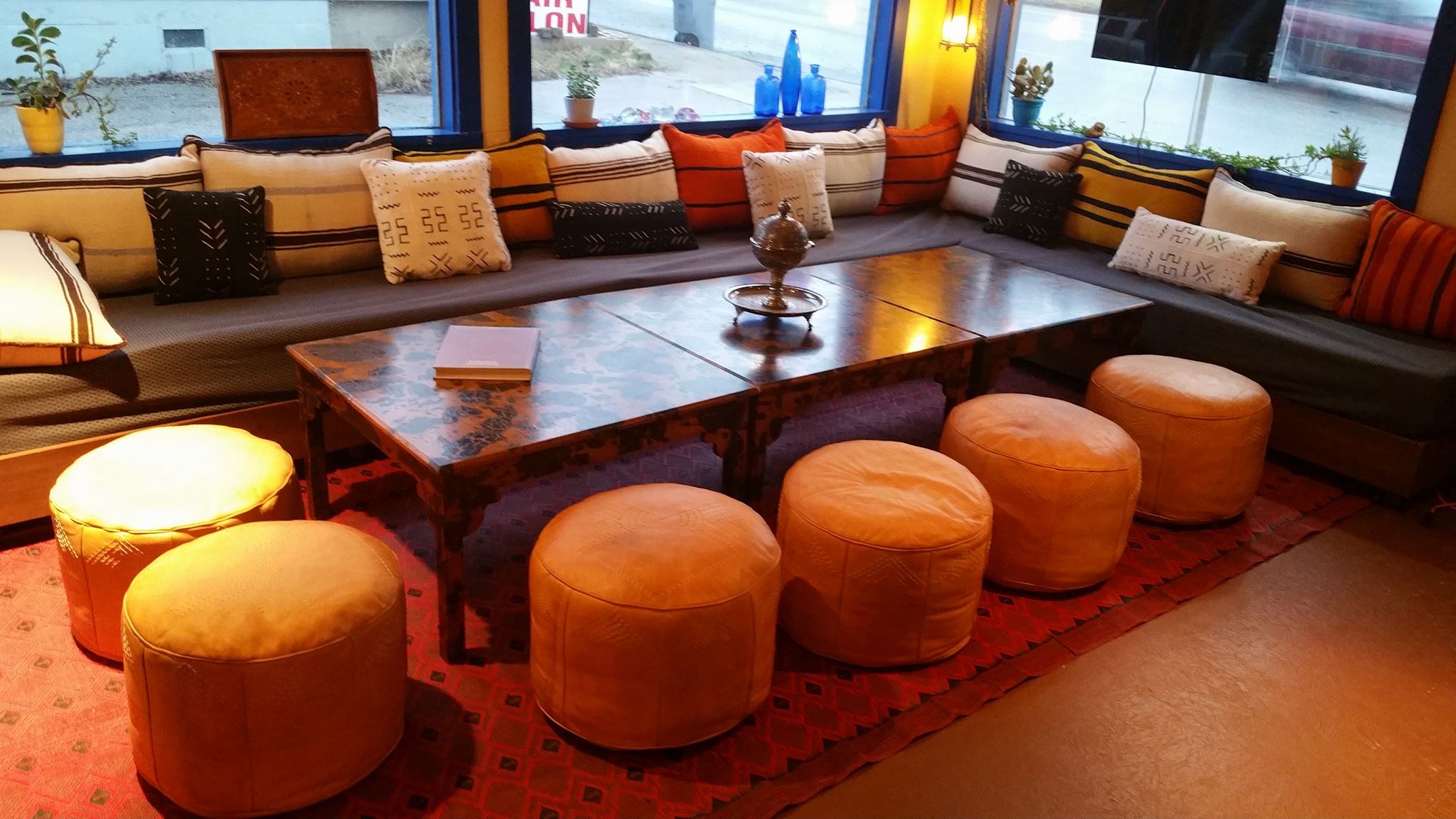“When I was around 10, I remember we would go to the streets and see the barbecue at the market (souk) for sandwiches, and we would buy it and enjoy it for cheap. I wanted to share those same moments with the people [around me] when I moved here,” he shared. Together with his wife Maria, after finishing their day jobs both head over to their own little souk, a popular food trailer, to offer dinner service to locals five days a week.

“When we decided to start [the restaurant], he was missing home, and he was just calling and asking his mom, ‘how do you make this, and how do you make that.’ He is just a natural [cook], some people are just natural,” Maria told us, smiling at her husband. “My thing was that I loved him so much and I wanted to make that food for him. That is what got us in the kitchen together, and I was like, I need to learn to make these things because I want to keep this guy; I got into food because I loved him.”
It was his mother who was a huge influence on Abderrahim, Maria explained. “He came from a family that cooked, you know—they cook like maniacs over there and most of them are chefs. They have some women who could be [professional] chefs, and that was the birth of his passion.”
Since opening in 2010 to serve Moroccan souk food, what began as a fond connection to his Moroccan childhood for Abderrahim, ‘Abdu’ as his friends and customers call him, has now become a favorite for their neighborhood regulars. It’s with a genuine sense of generosity that Abdu and Maria open their food trailer to serve their guests, even after long work days for them both. In fact, it’s not uncommon that during your trip for dinner you may find yourself chatting with the couple and find friends lingering over a welcoming cup of customary Moroccan mint tea.

Several tables and benches are available outside for walk-up dinner service, but take a walk into the blue façade of the building next to the aromatic food trailer where Abdu and Maria prepare the food, and you’ll be delighted by all the sights of the Moroccan interior. Throughout, you’ll find tasteful and carefully chosen tributes to traditional Moroccan decor.
From beautiful wooden tables and sofas hand-built by Abdu, who was a carpenter back in his hometown and port city of Mohamedia, to a traditional feminine energy you can feel through soothing yellow walls that reminded Maria of the desserts, accents of Moroccan blue, delicate arches and lambs, colorful pillows, paintings of women in folk-ware—the source of Moroccan food culture—as well as lovely silver tea ware just waiting to be served.

And the menu. It would be a dare to challenge you to find something you won’t like. Flavorful Moroccan spices fill every innovative vegetable, meat, or salad dish you could order on the inspired menu at the eatery. Many times, Abdu tells me, patrons will try a vegetable they’ve tried before that they didn’t like and totally love it because of the marinades he whips up. “It’s how we mix the food, the meat with the eggs and tomatoes, and how we match things. You feel the flavor, and you love it. The way we cook it, it’s kind of like we give the food the time it needs. When we spice even, we’re careful to put exactly what it’s supposed to be,” he shared.
Abdu explained to me that the flavorful cuisine is in many ways due to historical influences on Morocco from several different Mediterranean countries, including France, Spain, Portugal, and Italy. Although, it’s also important to know that each region and ancestral tribe in Morocco also features its own unique way of cooking which sets them each apart.

“It’s not just about the spices, but because of my family and how we cook. Every family is different. In fact, our [Bedouin] tribe is one of the biggest tribes; you’ll find many large tribes in Morocco, so in each region when you eat the food it’s totally different the way they cook it, and each has a specialty,” he explained.
For example, he tells me, when you go to Fez, they’re the best for Pastilla, a pie-shaped dish made with filo dough that all Moroccan’s can make, and that’s even customary for weddings, but in Fez they’re exceptionally good at it. He gives other examples, like the food of the mountain tribes who are well-known for a pea soup called Bissara because no one cooks it like them. For Bedouin’s, he says, it’s the couscous, and dishes like lemon-flavored djaj (chicken) and beef kafta with all kinds of spices—they’re known for their grilled meats and barbecue.
Come for dinner Tuesday through Saturday from 6:00 PM to 10:00 PM, and you’ll find a unique spin in the presentation of the dishes and how they are inspired by traditional Moroccan food combinations. Meals translated from being served in terra cotta pots called tagines into fresh marinated meat and vegetarian-style wraps, for example, or deconstructed plates served with French-style fries and a savory green salad with a citrusy dressing, are some of the things that fill the menu. Although when it comes to preparation, ingredients, and flavor, it’s very Moroccan, Maria told me.

“We hand-cut [everything], like the cilantro and parsley, and hand-peel the garlic. In Morocco food is a meditation, so everything is handmade here, and you can taste it,” she shared. “Sometimes [Abdu] will go to three or even four different places in a day to get the food we need for that night, and we curate the food by picking it as we go.”
You’ll find the grilled chicken, for example—with its fresh parsley, cilantro, good olive oil, and lemon—is marinated all night and then put on the grill right when you order it. Sauces are also a big deal at the trailer Maria tells me because Morocco was a French colony, so you’ll find three flavorful aioli options to add to every dish. After dinner, you can order up a side of freshly brewed Moroccan mint tea or almond-butter stuffed Medjool dates to curve your sweet tooth.
When you come for a visit, you’ll see that Abdu and Maria carry in their little eatery the very nurturing spirit of Morocco’s people. “[In Morocco], you always love people, you love families, and you can see that in our restaurant,” he says. “You can see our hearts are speaking when you eat the food because we cook from our hearts … you want it to be done well. We grow up with our parents and grandparents, and they take care of the kids and cook, and as children we can taste that food and feel the love.” Ask me, and I believe that’s the kind of experience everyone will have when arriving for dinner at The Flying Carpet.




